Elbit Systems of America showcases the Sigma Next Generation Howitzer at AUSA 2024, where competing systems from Sweden, South Korea, France, and Germany are likely to be presented, some in models, others in full size. Before the event, the company sheds light on the new Self-propelled, automated artillery system that will soon enter operational service with the Israel Defense Forces (IDF) and is proposed for the US Artillery of the Future.
Mounted on the Oshkosh MAP 10×10 platform, the system allows simple operative mobility without tank carriers while maintaining good tactical all-terrain mobility. The highly automated system is operated and controlled remotely by three crew members seated in a protected cab. With a 155mm 52 Cal barrel, the gun is coupled to an automatic loading system, feeding continuous fire at eight rounds per minute on high-volume fire missions.
Fully automatic loading and gun laying enable the crew to engage in two missions simultaneously with a single gun unit. Onboard fire data calculations enable quick fire dispersion and a short response time of less than 60 seconds from travel to fire. The system can use a ‘Digital Area Fires’ method that reduces traditional artillery engagement and supply bottlenecks, providing fully automated mission assignments, target data, and ammunition supply.
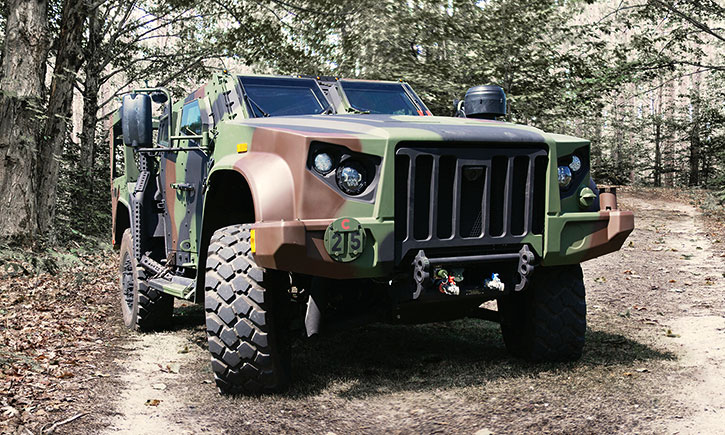 AM General Showcases Advanced Tactical Vehicles at AUSA 2024
AM General Showcases Advanced Tactical Vehicles at AUSA 2024
AM General is introducing its new JLTV A2 general-purpose 4-passenger vehicle at the AUSA 2024 exhibition. According to the company, it is an upgraded version of the first-generation model. This vehicle boasts improvements in powertrain, noise reduction, and corrosion protection. The vehicle has a 2024MY L5P Duramax engine, the same model powering commercial heavy-duty trucks. A new transmission gear coding improves shifting and optimizes fuel efficiency without compromising performance. A single 24V Lithium-Ion battery replaces the two 12V batteries in A1 models, saving weight and space. The new battery is part of an enhanced electrical architecture that prepares the JLTV for future hybridization.
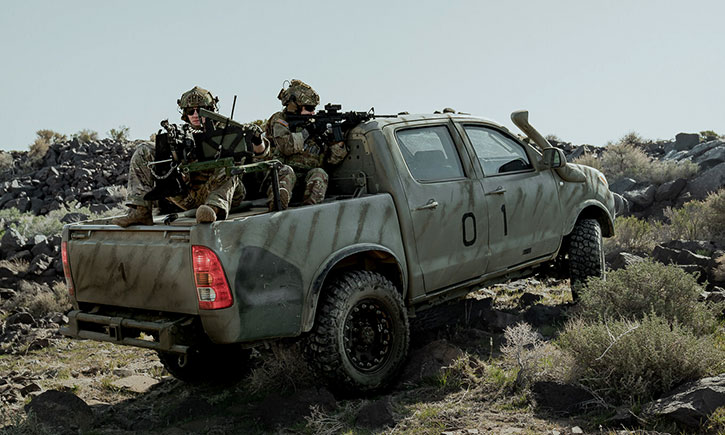 Alongside the JLTV A2, AM General showcases the MIMIC-V (Mission Integrated Maneuverable Interoperable Conformable Vehicle) prototype, a ground-up build designed for special operations. This high-performance, low-signature truck can operate in various environments and has the unique ability to mimic the appearance of a commercial vehicle, enhancing its tactical versatility. With a curb weight of 4,626 kg and Gross Vehicle Weight (GVW) of 5670 kg, the vehicle’s powertrain uses an I-4 Turbocharged 4.5 litre Cummins Diesel engine delivering 180 HP, and upgradable to +250HPwith 6-speed Allison transmission, 2WD, 4WD high and 4WD low transfer case. The vehicle is pre-wired for advanced communications, electronic countermeasure systems, and FLIR tower expandability.
Alongside the JLTV A2, AM General showcases the MIMIC-V (Mission Integrated Maneuverable Interoperable Conformable Vehicle) prototype, a ground-up build designed for special operations. This high-performance, low-signature truck can operate in various environments and has the unique ability to mimic the appearance of a commercial vehicle, enhancing its tactical versatility. With a curb weight of 4,626 kg and Gross Vehicle Weight (GVW) of 5670 kg, the vehicle’s powertrain uses an I-4 Turbocharged 4.5 litre Cummins Diesel engine delivering 180 HP, and upgradable to +250HPwith 6-speed Allison transmission, 2WD, 4WD high and 4WD low transfer case. The vehicle is pre-wired for advanced communications, electronic countermeasure systems, and FLIR tower expandability.
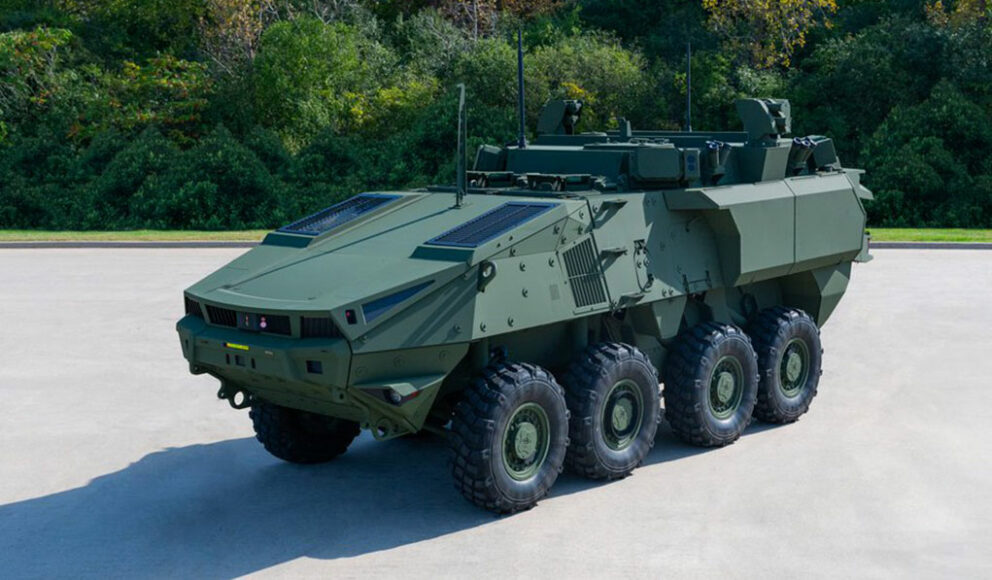
General Dynamics Showcases Advanced Military Technologies at AUSA 2024
General Dynamics Land Systems will showcase its Mission Command on the Move (MCOTM) concept, featuring three new vehicles making public debuts. These include the Stryker MCOTM with hybrid-electric drive and integrated Active Protection System, the MUTT XM robotic vehicle for equipment carrying and combat support, and the TRX Defender modular robotic combat vehicle. These vehicles are designed to reduce detectable signatures and improve mobility and flexibility in combat situations.
Stryker MCOTM: With increased interior space thanks to a raised roofline, the Stryker MCOTM is the crewed hub that enables protected mission command on a short halt or on the move. Its hybrid-electric drive allows for silent mobility, watch, and exportable power. It also boasts an integrated Active Protection System, Next Generation Electronic Architecture with cyber defense, and individual communication devices for end-to-end secure communications at the echelon. Integrating innovative intra-command post communications helps substantively reduce electromagnetic signatures, enabling the MCTOM command post to “hide in plain sight.” The MCOTM solution uses Human-Machine Integration (HMI) to reduce detectable friendly signatures across several spectrums, including visual, thermal, acoustic, and electromagnetic. It also eliminates the need for noisy generators, cumbersome tents, extra support vehicles, and other logistics burdens that consume valuable resources and manpower.
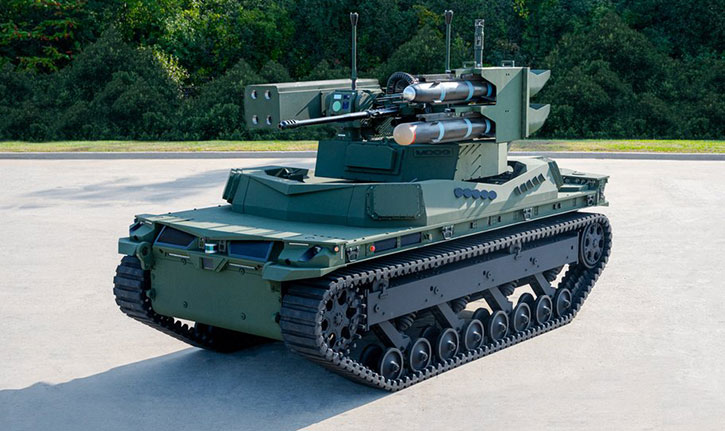
In the three days at AUSA, the 10-ton TRX Defender GDLS robotic platform will be displayed with different ground and air defense payloads. Now in its third generation, the latest TRX is the Land Systems entry in the Army Robotic Combat Vehicle (RCV) competition with a 1:1 ratio for curb weight-to-payload. The TRX payloads on display are designed to provide perimeter defense against air and ground threats during an MCOTM operation, unencumbering subordinate units from being tasked with command post defense.
MUTT XM: The newest member of the Land Systems family of Multi-Utility Tactical Transport robotic vehicles, it is bigger, faster, and stronger than its predecessors and is hardened against electromagnetic interference. The 8×8 MUTT XM lightens the load as an equipment-carrying “robotic mule” but also has built-in flexibility for various combat, combat support, and combat service support functions and payloads. On display at AUSA, it will be outfitted with MIMIC spoofing technology from General Dynamics Mission Systems, providing a deployed layer of protection for the MCOTM command vehicles.
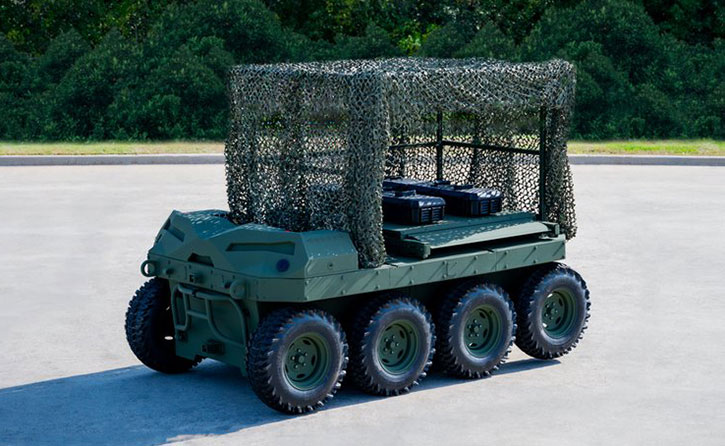
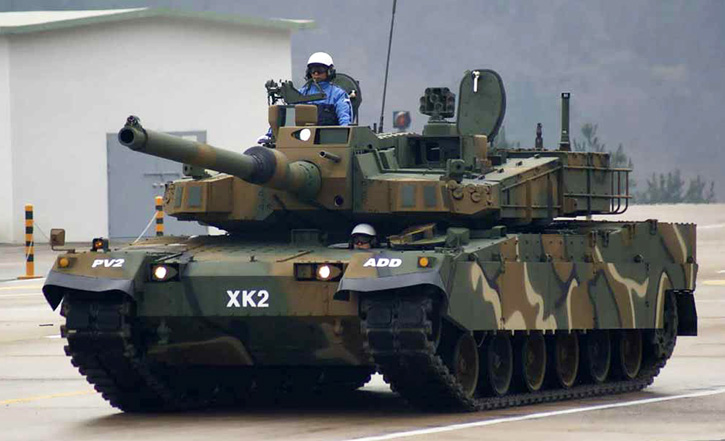
As South Korea Delivers More K2 MBTs to Poland, Armenian Shows Interest
South Korean defense firm Hyundai Rotem has delivered a new batch of six K2 Black Panther main battle tanks to Poland, as announced by the country’s defense procurement agency on October 4. This delivery is part of a contract signed in 2022, worth nearly USD 3.4 billion, for the supply of 180 K2 tanks to the Polish Armed Forces. This announcement comes after sources in Poland expressed concerns about delays.
With this latest addition, the Polish Army’s fleet of K2 Black Panthers will increase to 62 units. The delivery schedule remains on track, with Hyundai Rotem expected to provide an additional 22 tanks by the end of this year and 96 more in 2025. The company successfully delivered 22 K2 tanks to Poland in 2023, maintaining its commitment to complete all deliveries by the end of 2025.
Poland’s acquisition of K2 tanks is part of a larger agreement with Hyundai Rotem for 1,000 tanks, signed in July 2022. While the initial 180 tanks are manufactured in South Korea, the remaining units will be produced domestically in Poland under the K2PL standard. This localized production aims to incorporate subsystems from Polish manufacturers, supporting the government’s goal of establishing local production capabilities. To facilitate this, Poland’s state-owned defense holding PGZ and Hyundai Rotem signed a consortium agreement in July 2024 to jointly produce K2PL tanks in Poland.
Armenia is also interested in the Korean K2. Since its military defeat and withdrawal from the Nagorno Karabakh region, Armenia has increased its defense spending, allocating USD 1.28 billion for 2023, marking a 46% rise from the previous year. This budget is expected to reach approximately USD 1.4 billion in 2024. Armenia has historically been dependent on Russia for its military equipment, but recently, Armenia has diversified its suppliers, partly due to Moscow’s inability to fulfill current contracts. acquiring artillery and rockets from India, and now negotiating the acquisition of Main Battle Tanks in Korea.

Rheinmetall to Supply New Tank Ammunition for German and British Armies
Rheinmetall has announced the successful development of its latest generation of enhanced armor-piercing 120mm KE ammunition, designed to counter state-of-the-art protection technologies. The German Bundeswehr and the British Army have commissioned the company to manufacture qualification samples of the new KE2020Neo or eKE (enhanced Kinetic Energy) ammunition.
The 120 mm x 570 KE2020Neo kinetic energy ammunition is the latest in Rheinmetall’s kinetic energy (KE) rounds family. It features a high-strength tungsten penetrator capable of penetrating the most advanced protection technologies. This new ammunition builds upon Rheinmetall’s history of developing increasingly powerful KE projectiles, from the first generation DM13 to the current DM73. Rheinmetall developed two types of performance-enhanced KE ammunition when the Leopard 2 was upgraded to the A6 version. These were the forerunners of the DM53 and DM63 models used by the Bundeswehr. The DM63 is now available in the REACh-compliant version A1. The enhanced DM73 is currently the most advanced iteration, introduced in the Bundeswehr for the L55A1 high-pressure weapon.
Rheinmetall’s current KE projectiles also use a high-strength tungsten penetrator, offering superior performance against modern armor. The first generation to come into use was the DM13. The more powerful DM23 followed it in the mid-1980s, and the DM33. Rheinmetall developed two types of performance-enhanced KE ammunition when the Leopard 2 was upgraded to the A6 version. These were the forerunners of the DM53 and DM63 models used by the Bundeswehr. The DM63 is now available in the REACh-compliant version A1. The enhanced DM73 is currently the most advanced iteration, introduced in the Bundeswehr for the L55A1 high-pressure weapon.
The qualification contract was signed in September 2020 by the Federal Office for the Equipment, Information Technology, and In-Service Support of the Bundeswehr (BAAINBw) and Rheinmetall Waffe Munition GmbH. The company’s 120mm smoothbore technology, including Rh120 guns and related ammunition, is widely used in NATO and Western hemisphere main battle tanks, such as the Leopard 2, M1 Abrams, and the upcoming British Challenger 3.
Romania Receives First Batch of Otokar Cobra II Armored Vehicles
The Romanian Ministry of National Defence has received Turkey’s first batch of Otokar Cobra II 4×4 armored vehicles.
More news this week:
- Elbit Systems Address US Army Artillery Modernization with Sigma 155×52 Wheeled Howitzer
- Unmanned Combat Aerial Vehicle Program Launches as Part of Rafale F5 Standard
- Steadicopter Unveils Golden Eagle HS ATGM Launching Aerial Platform
- Air Defense & C-UAS Innovations at the AUSA 2024 Exhibition




















